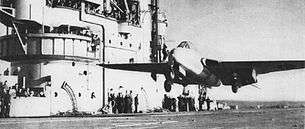HMS Ocean (R68)
_off_Korea_c1952.jpg) HMS Ocean off Korea in July 1952 | |
| History | |
|---|---|
| Laid down: | 8 November 1942 |
| Launched: | 8 July 1944 |
| Commissioned: | 8 August 1945 |
| Decommissioned: | 1960 |
| Out of service: | In reserve, 1957 |
| Fate: | Scrapped in Faslane, Scotland 1962 |
| General characteristics | |
| Class and type: | Colossus-class aircraft carrier |
| Displacement: | 13,190 tons |
| Length: | 630 ft (190 m) |
| Beam: | 80 ft (24 m) |
| Draught: | 18 ft 6 in (5.64 m) |
| Propulsion: |
|
| Speed: | 25 knots (46 km/h) |
| Range: | 12,000 nm at 14 knots (22,200 km at 26 km/h) |
| Complement: | 1,300 officers and men |
| Armament: |
|
| Aircraft carried: | 48 |
HMS Ocean was a Royal Navy Colossus-class light fleet aircraft carrier of 13,190 tons built in Glasgow by Alexander Stephen and Sons. Her keel was laid in November 1942, and she was commissioned on 30 June 1945.
In March 1944, a proposal was made by the Australian Government to purchase a light fleet carrier, specifically Ocean.[1] The decision was rejected in early June 1945, and the carrier entered Royal Navy service.[1]

On 4 December, 1945, a Sea Vampire flown by Eric "Winkle" Brown made the first ever carrier landing of a purely jet-powered aircraft onto Ocean (although earlier that year a composite jet and piston engined Ryan FR-1 Fireball had made a carrier landing under jet power after its radial engine failed.)[2] The last Fairey Swordfish to make an official flight from a Royal Navy aircraft carrier did so earlier in October 1945 from the deck of Ocean. When British forces withdrew from Palestine in 1948, Ocean supported the withdrawal.
Ocean twice deployed to Korea, firstly from May to October 1952 and then from May to November 1953. In August 1952 a formation of Hawker Sea Fury aircraft from the carrier engaged North Korean MiG-15 jets in air combat, shooting one down.[3]
In August 1954 she joined the Home Fleet's Training Squadron but saw an active role in the Suez crisis. In the first ever large-scale helicopter borne assault, Westland Whirlwind and Bristol Sycamore helicopters from Ocean and HMS Theseus landed 425 men of 45 Commando and 23 tons of stores into Port Said in 90 minutes. After Suez, the ship did not see much more active service. She went into Extended Reserve in 1958 and was scrapped in 1962 at Faslane.
In his book on the Hungarian Revolution, Peter Fryer briefly refers to the "arrest of twelve British seamen in the aircraft carrier Ocean, following unlawful meetings" in October 1956.[4]
References
- 1 2 Wright, Anthony (June 1998) [1978]. Australian Carrier Decisions: the acquisition of HMA Ships Albatross, Sydney and Melbourne. Papers in Australian Maritime Affairs (No. 4). Canberra: Sea Power Centre. pp. 55–109. ISBN 0-642-29503-4. ISSN 1327-5658.
- ↑ "First Jet Landing." Naval Aviation News, United States Navy, March 1946, p. 6. The first jet aircraft to operate from an aircraft carrier was the unconventional composite propeller-jet Ryan FR Fireball, but it was designed to utilize its piston engine during takeoff and landing. On 6 November 1945, the piston engine of an FR-1 failed on final approach and the pilot started the jet engine and landed, thereby performing the first jet-powered carrier landing, albeit unintentionally.
- ↑ McCart, Neil The Colossus-Class Aircraft Carriers 1944-1972 Cheltenham 2002 pp100-1 ISBN 1901225062
- ↑ Fryer, Peter (December 1996) [1956]. Hungarian Tragedy. London: New Park. pp. 39–40. ISBN 0861510720.
- Aircraft Carriers of the World, 1914 to the Present An Illustrated Encyclopedia by Roger Chesneau - Brockhampton - ISBN 1-86019-875-9
External links
| Wikimedia Commons has media related to HMS Ocean (R68). |
